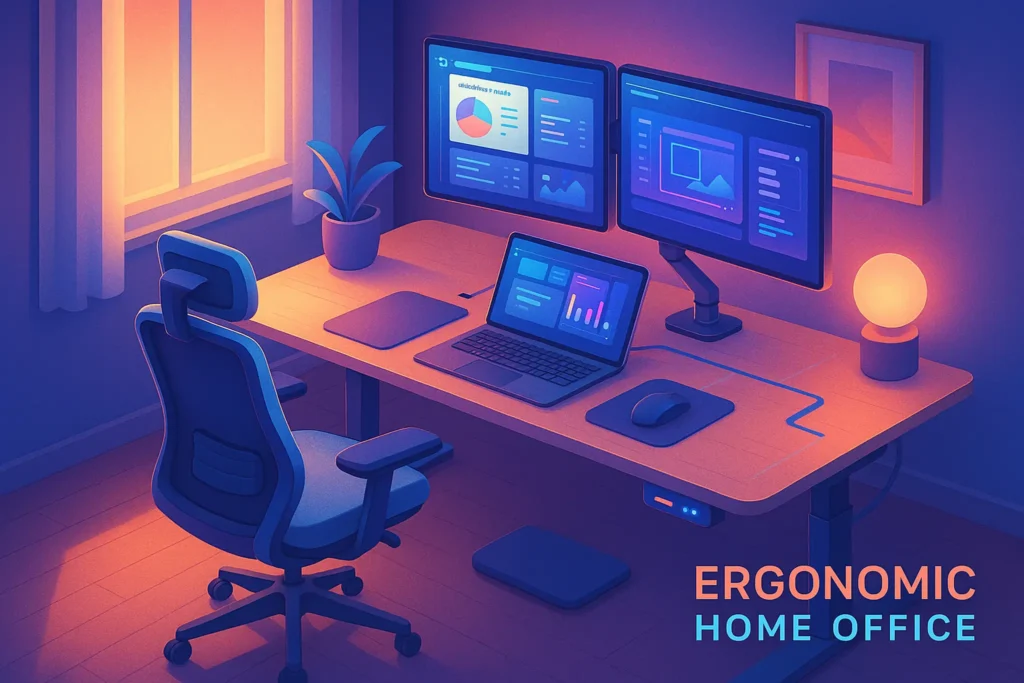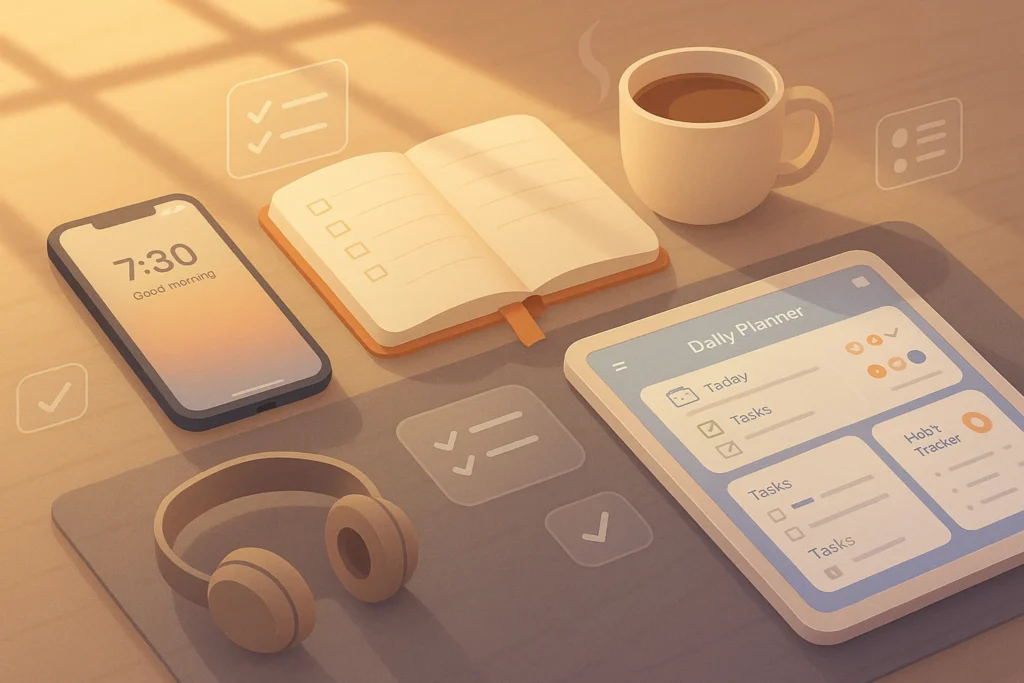🧠 Why Ergonomics Matter in a Home Office
The rise of remote work has brought unprecedented flexibility — but it’s also introduced a silent productivity killer: poor ergonomics. Many home setups are cobbled together from kitchen tables, spare chairs, and whatever lighting is nearby. While workable in the short term, these setups can slowly lead to chronic back pain, neck strain, eye fatigue, and even reduced cognitive performance.
Ergonomics isn’t just about comfort; it’s about aligning your work environment to your body’s natural posture and movement patterns. Proper chair height supports spinal alignment, correct monitor placement reduces neck strain, and well-lit spaces prevent eye fatigue. Over time, these factors directly impact output. Studies have shown that employees in ergonomic environments can experience up to a 25% productivity boost compared to those in poorly designed spaces.
It’s the same principle we explored in Upgrade Your Home Office — optimizing your workspace isn’t a luxury, it’s an investment in both health and output. An ergonomic home office can help you work longer without discomfort, focus more easily, and end the day with energy to spare.
💡 Nerd Tip: When was the last time you adjusted your chair height or monitor angle? If you can’t remember, it’s probably time to tweak your setup.
✅ Chair & Desk Height: Getting the Basics Right
Your chair and desk are the foundation of your ergonomic setup. Get them wrong, and every other improvement is just damage control.
The ideal desk height generally allows your elbows to rest at a 90-degree angle while typing, with your forearms parallel to the floor. For most people, that’s around 28–30 inches from the floor, but body height plays a big role. Chairs should be adjusted so your feet are flat on the floor (or on a footrest) with knees bent at about 90–100 degrees.
A standard ergonomic chair offers lumbar support, adjustable height, and a reclining backrest. A premium ergonomic chair (think Herman Miller Aeron or Steelcase Gesture) adds fine-tuned adjustments for seat pan depth, armrest positioning, and lumbar firmness, ensuring the chair adapts to your body, not the other way around.
Standing desks are worth considering if you like to alternate between sitting and standing during the day. The key is to adjust them so that when standing, your elbows are still at that 90-degree angle, and the monitor is at eye level. In our deep dive on Portable Monitors and Other Underrated Productivity Gadgets, we highlighted how pairing a standing desk with an adjustable monitor setup can unlock serious flexibility.
💬 Monitor Positioning for Eye & Neck Health
One of the most common ergonomic mistakes is placing your monitor too low or too far away. This forces you to crane your neck down or forward, leading to discomfort over time. Ideally, the top of your monitor should be at or slightly below eye level, and the screen should be about an arm’s length (20–30 inches) away.
Monitor arms are a game changer here. They allow precise height and distance adjustments, making it easy to fine-tune positioning for both sitting and standing work. Plus, they free up valuable desk space. If you often work from a laptop, a laptop stand paired with an external keyboard and mouse can mimic the ergonomic benefits of a desktop monitor setup.
For those working with multiple screens — maybe you’re running virtual meetings while referencing documents — keep your primary screen directly in front of you, and angle secondary screens slightly inward to reduce head turning. This is especially important if you want to avoid neck strain during long sessions, such as the ones we discussed in Pro Tips for Better Virtual Meetings.
🖐 Keyboard & Mouse Ergonomics
Your keyboard and mouse are your most frequently touched tools, so their design and placement matter. Your keyboard should allow your wrists to remain straight while typing — no excessive bending outward or upward. Split keyboards can help maintain a more natural wrist position, reducing strain during long typing sessions.
For mice, ergonomic vertical designs can keep your wrist in a handshake position, which reduces pronation and associated strain. If you spend hours on creative work or data entry, a trackball mouse can also reduce repetitive stress.
Position both keyboard and mouse so your elbows stay close to your body, and your wrists hover just above the surface. Wrist rests can provide support, but they should be used between typing or mouse movements, not while actively inputting.
If you often switch between your computer and your smartphone for work, consider the recommendations from Must-Have Phone Accessories for Productivity — certain docks and stands can keep your phone at eye level, reducing neck strain from constantly looking down.
💡 Lighting for Comfort & Focus
Lighting impacts more than just visibility — it affects mood, focus, and even your sleep cycle. Natural light is ideal, but direct sunlight can cause glare on screens. The goal is to position your desk near a window, ideally with light coming from the side, not directly in front or behind your monitor.
For artificial lighting, full-spectrum LED lamps can mimic daylight and reduce eye strain. Adjustable desk lamps with both brightness and color temperature controls let you adapt lighting for different times of day — cooler light for focus during work hours, warmer light to wind down.
Don’t forget ambient lighting. A well-lit room reduces the contrast between your monitor and surroundings, easing the strain on your eyes. This is particularly useful if you work into the evening, when harsh overhead lighting can cause discomfort.
In the same way we explored in Pro Tips for Maximizing Your Smartphone’s Battery Life, small adjustments — like dimming your lights at certain hours — can have outsized benefits for comfort and long-term well-being.
🧠 Recommended Ergonomic Gear
Upgrading your gear doesn’t have to mean replacing everything at once. Focus on the items that will make the biggest immediate difference:
-
Ergonomic chairs: Models like the Steelcase Series 1 or Herman Miller Aeron adapt to your body and support natural posture all day.
-
Standing desks: Brands like Uplift Desk or Fully offer sturdy, adjustable-height options.
-
Monitor arms: Ergotron or AmazonBasics models allow precise positioning and space-saving flexibility.
-
Laptop stands: Rain Design mStand or MOFT foldable stands are portable and effective.
-
Wrist supports: Memory foam pads can ease pressure during breaks between typing.
🎨 Quick Ergonomic Audit
Ask yourself:
-
Are my elbows at 90 degrees when typing?
-
Is my monitor’s top edge at or below eye level?
-
Can my feet rest flat on the floor?
-
Is my lighting balanced without glare?
Budget vs Premium Setup
| Feature | Budget Option | Premium Option |
|---|---|---|
| Chair | Basic ergonomic office chair | Herman Miller / Steelcase |
| Desk | Fixed-height desk + footrest | Motorized standing desk |
| Monitor Setup | Simple riser stand | Fully adjustable monitor arm |
| Lighting | LED desk lamp | Adjustable color-temp LED lamp |
💺 Want More Pro Tips for Your Workspace?
Join our free newsletter and get weekly ergonomic and productivity insights — from expert gear picks to proven home office hacks.
No fluff, just actionable advice to help you work smarter and feel better.
🔐 100% privacy. No spam. Just value-packed tips from NerdChips to upgrade your comfort and performance.
Mini Case Study: Real Workspace Transformation
Sarah, a freelance graphic designer, used to work 8–10 hours a day from a basic dining chair and a low desk. She suffered from chronic neck tension and lower back pain, which reduced her daily output. After investing in a premium ergonomic chair, an adjustable standing desk, and a monitor arm, her discomfort dropped by 80% within two weeks. She also reported being able to focus for an extra hour each day — translating to more projects completed and higher monthly income.
Common Mistakes to Avoid
Even with good equipment, many people sabotage their ergonomics by:
-
Placing the monitor in direct sunlight, causing glare and eye strain.
-
Working long hours on a laptop without a stand, forcing a hunched posture.
-
Keeping the keyboard and mouse too far away, leading to extended arm reach and shoulder fatigue.
Avoiding these errors is as important as buying quality gear.
Stretch & Movement Plan
Ergonomics isn’t just about furniture — movement matters. A 3–5 minute micro-break every hour can prevent stiffness and improve circulation. Try:
-
Neck stretches: Slowly tilt your head side-to-side and forward/backward.
-
Shoulder rolls: 5 forward, 5 backward.
-
Wrist flexion/extension: Rotate wrists gently in both directions.
-
Standing quad and hamstring stretches: Hold each for 15–20 seconds.
These small actions compound over the day to keep muscles loose and reduce fatigue.
Impact on Long-Term Health
A well-designed ergonomic workspace isn’t just about feeling good today — it’s about preventing chronic issues tomorrow. Poor posture can lead to conditions like carpal tunnel syndrome, herniated discs, and persistent neck pain. By aligning your workstation with ergonomic principles now, you reduce the risk of medical interventions, lost workdays, and decreased quality of life in the future.
Ergonomic ROI (Return on Investment)
Ergonomic upgrades can feel expensive upfront, but the payoff is measurable. For example, a $300 chair that prevents chronic back pain could save thousands in physiotherapy costs. More importantly, it can boost productivity — if a better setup lets you work just 30 extra focused minutes per day, that’s over 120 extra hours of productive time per year. Viewed this way, ergonomic investments are not costs but profit multipliers.
🧠 Nerd Verdict
An ergonomic home office is not about luxury — it’s about longevity. The right setup protects your health, boosts focus, and helps you work at your best for years to come. Investing in ergonomics now means avoiding costly breaks and burnout later.
❓ FAQ: Nerds Ask, We Answer
💬 Would You Bite?
When was the last time you gave your home office a full ergonomic checkup — and what’s the one upgrade you know you need?



